Last year, the average price paid for a new car was about $35,000. But that doesn’t mean you have to pay $35k to drive home a new car.
A nice new car.
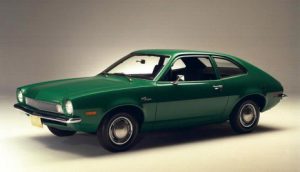
You could, for example, buy a brand-new Nissan Versa – with AC, with a four speaker stereo (Bluetooth, too!) and intermittent wipers – for just under $12k, sticker.
A Pinto re-imagined, it’s not.
Even better, it’s not small.
WHAT IT IS
The Versa sedan is the least expensive new car sold in America.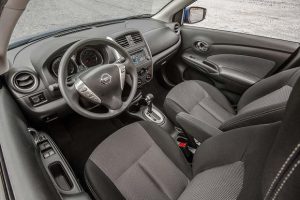
It’s a compact sedan in terms of its overall size – but it has a mid-sized sedan’s interior space, including a backseat with 37 inches of legroom and an almost 15 cubic foot trunk, about the same as a Toyota Camry – or Nissan’s own Altima sedan.
Same-size on the outside rivals like the Hyundai Accent sedan have much less space inside – 33.5 inches of backseat legroom and a 13.7 cubic foot trunk. These much more cramped interior dimensions are typical of rivals in the Versa’s class.
Base price is $11,990 for the S trim with manual transmission; $14,130 for the S Plus trim with continuously variable (CVT) automatic transmission.
A base trim Hyundai Accent sedan with manual transmission and that tight back seat stickers for $14,995 – about $3,000 more than the Nissan. That’s a big difference. It works out to a savings of about $125 per month over two years – which money could be put toward gas or some other thing.And there’s another difference.
Intermittent wipers are now standard in all trims, including the $11k and pocket change S.
The SV Special Edition package that Nissan made available last year continues for 2018. Order this and your Versa will come outfitted Cadillac-style, with leather trim, fog lights and a color LCD touchscreen with streaming audio and Messaging Assistant hands-free texting.
WHAT’S GOOD
Price can’t be beat.
Room for the price can’t be beat.
Essentials features (AC, a very decent stereo) are included in that price.
Luxury options available, if you wish.
Simple drivetrain – not yet direct injected, no turbo, no ten speed transmission.
Bluetooth is standard – but some convenience features – cruise control, power windows, Sirius/XM satellite radio – aren’t available in the base S trim.
Lowest cost S trim is manual transmission only. Nicer-trimmed S Plus and SV are automatic-only. No mixing and matching.
More versatile five-door hatchback version is now a separate – and higher cost – model (the Versa note; base price $15,600).
The Versa’s standard engine is a 1.6 liter four cylinder driving the front wheels via either the standard (in S trims) five-speed manual transmission or (in S Plus and SV trims) a continuously variable (CVT) automatic transmission.
The engine makes 109 hp and 107 ft.-lbs. of torque.
Nothing special – which is exactly why it is special.
The Versa’s engine remains a relatively simple engine, as modern car engines go. It isn’t pressurized by a turbocharger, for instance – something that has become very commonplace even in economy cars – though whether this is a good idea in an economy car is hugely debatable.
Turbocharged engines are much more complicated engines. There are more parts – which means more possibilities for problems – and expenses – down the road. Turbocharged engines are also stressed engines – being pressurized engines. They have to work harder and endure more . . stress. 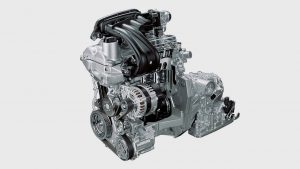
The Nissan’s isn’t – and doesn’t.
This includes its compression ratio – which is a still-reasonable 9.8:1 vs. the close-to-diesel compression ratios becoming not uncommon in other engine designs. Higher compression does give higher performance (power) and an fuel efficiency boost. Mazda’s “SkyActive” family of engines use this method to deliver both those things. Which makes them zippier things.
But Mazdas do cost more – and possibly down the road, too. The higher cylinder pressures in a high-compression engine often mean compression loss (and leakage) as the miles rack up. That blue smoke you sometimes see coming out of an older car’s tailpipe . . .
The Versa’s engine (which also still uses port fuel injection rather than the becoming ubiquitous direct injection, which involves two fuel pumps and fuel pressurized to several thousand PSI vs. 30 or so PSI) is as close as you’ll find to something like an economy car engine in a modern economy car.
Despite not having all the “latest fuel saving technology” – a turbo, high-compression/direct injection – the Versa’s mileage is still very close to top-of-the pack: 27 city, 36 highway with the manual transmission and 31 city, 39 highway with the CVT automatic.
As a cross-comparison, the Hyundai Accent’s standard 1.6 liter engine does have “the latest fuel saving technology” – including direct injection and very high (11.0:1) compression – but its mileage numbers are about the same for the manual-equipped model (28 city, 37 highway) and a couple of MPGs worse with the optional automatic (28 city, 38 highway).
The Hyundai’s engine is stronger – 130 hp and 119 ft.-lbs. of torque – and the Accent is quicker – zero to 60 in about 8.3 seconds vs. about 9.2 for the Versa.
But in an economy car, shouldn’t economy be the priority?
You’ve heard of Einstein’s Theory of Relatively. It is the idea that – among other things – speed is relative. On Earth, 600 MPH is speedy. In space, it’s hardly moving.
How speedily does most traffic actually move?
Most of the time, not very.
Notwithstanding all the power. Next time you’re out and about, observe how tepidly most drivers accelerate when a traffic light goes from red to green; how meekly they merge. All that power – going nowhere fast. It’s a weird disconnect. The average family car is quicker and faster – in terms of what it could do – than most high-performance sports car were back in the ’70s and ’80s.
But speed limits are still what they were 30 or 40 years ago on most secondary roads – and the torments applied for exceeding them are Medieval. This plus decades of passivity conditioning have resulted in the bizarre spectacle of 300 horsepower cars being driven as timorously as 82 hp K cars.
Which gives the advantage to the K car driver – or the Versa driver – if he’s prepared to use what he’s got.
In which case, 82 hp – or 109 hp – is plenty.
Especially if you’re paying attention. Anticipate the light going green. The guy next to you in his 300 hp whatever-it-is probably isn’t. He is probably texting – or just unfocused, his mind on other things. If you’re ready and he’s not – then you win.
Regardless of his theoretical under-the-hood advantage.
Try it and see.
Nine times out of ten, you’ll win in a car like the Versa – if you’re prepared and make use of everything you’ve got. This entails actually driving, of course – and that is an activity actively being discouraged. But – again – this can work to your advantage in the same way that laws forbidding radar detectors work to the advantage of the smarter set who ignore such laws.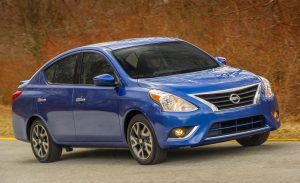
It is also fun. In the sense of the sage saying that it is more fun to drive a slow car fast than a fast car slow. And for the record, a 9-ish second time to 60 isn’t slow – even by modern standards.
If you want to experience a slow new car, try a Prius C hybrid. It needs 11 seconds to get to 60, which doesn’t leave much to work with.
On handling and such: Will the Versa out-corner (or out-brake) sportier-in-principle sedans? No, of course it won’t.
So?
Should it?
The ’72 Beetle I’m helping my Young Apprentice with doesn’t corner or brake like a sport sedan, either. But it is economical – and it’s a lot fun.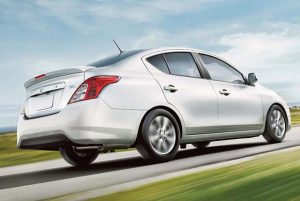
The Versa handles and brakes vastly better than the Beetle; in comparison, it’s a four-door Ferrari. Its limits are high enough that (unlike the Beetle) you have to work at it to reach them. In ordinary day-to-day driving, you will never approach them.
Who needs more?
If not, why pay extra for it?
Sedans aren’t as popular as they once were – arguably because they’ve become so much less practical than they once were. Especially in the Versa’s class – in which you get much more room for your money if you go with a hatchback or even a small crossover SUV. These have become extremely popular because they are practical. Their higher rooflines, wide-opening rear liftgates and backseats that fold flat make up for their small overall size.
But popularity has its price – reflected in the higher MSRPs of five-door hatchbacks and crossovers in the Versa’s class – including the Versa note hatchback.
These all start out several thousand dollar higher than the Versa sedan – and there’s less room to haggle that down . . . because they’re popular. If you don’t buy it, the guy behind you will.
But the Versa’s a very practical sedan – for its size and otherwise.
To get a handle on this, have a look at some key Versa stats – vs. the best-selling mid-sized car in the country, Toyota’s Camry sedan. The Versa is 175.4 inches long overall vs. 192.7 inches for the Camry, a difference in length of not far from two feet. Bu the Versa’s front and backseat legroom – 41.8 inches and 37 inches – are within a hair of the much larger on the outside Camry’s: 42.1 inches up front and 38 inches in the back.
Both cars have about the same trunk space, too: 14.9 cubic feet for the Versa vs. 15.1 cubic feet for the Camry.
But the Camry’s base price – $23,495 – is almost exactly twice the Versa’s base price.
And the Camry is among the roomier mid-sized sedans on the market right now. Most have considerably less room in the back. Nissan’s own Altima sedan (a Camry cross-shop) has just 36.1 inches of legroom in its backseats and only 15.4 cubic feet of trunk space, despite being two notches up the Nissan totem pole.
And in small sedan equivalents like the Hyundai Accent, you’d better assume the position. The fetal position. It only has 33.5 inches of backseat legroom – nearly four inches less than the Versa. That’s ok for young kids but tight for teens and harsh on adults – which makes a car like the Accent sedan much less practical than the Versa as a primary family car.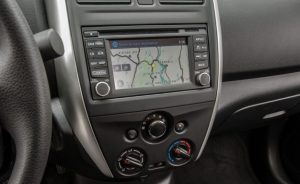
Also practical are the standard 15-inch steel wheels, which are sturdier than the aluminum wheels almost all new cars now come standard with (chiefly because they shave a little curb weight and also because they look snazzier than steel wheels with plastic trim covers). Steel wheels stand up better to potholes – and are much more resistant to warping caused by over-tightening of lug nuts, which happens a lot.
Ride quality is usually better on 15s, too – because there’s more shock-absorbing tire between you and the road than there is in a car riding on 16 or 17-inch wheels with short -and so, stiffer – sidewalls.
Steering response might not be as “sharp,” but we’re talking economy . . . right?
Replacement tires should cost you less, too.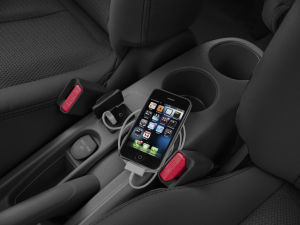
What used to cost you more are things like air conditioning and a serviceable audio system.
Both are standard in the sub-$12k Versa S – as are intermittent wipers. It’s a lot for the coin, particularly in historical context. Economy cars used to be defined by the absence of air conditioning; they maybe came with an AM radio, usually extra cost. Intermittent wipers? Might as well expect a ribeye on the Value Menu at McDonalds.
You toughed it out.
But when you can buy a brand-new car with AC, a better-than-decent stereo (four speakers, Bluetooth) and intermittent wipers for under $12k, how do you convince people to buy cars that cost more than $12k?
Well, you can restrict things like cruise control and power windows to the higher-priced cars. That and the optional CVT automatic transmission. These and a few other little things – like a rear seatback that folds fully flat – are what separate the $12k Versa S from the slightly pricier Versa S Plus and Versa SV.
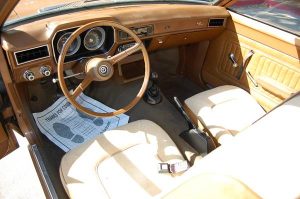
Also the Versa from cross-shops like the Accent sedan.
But the take-home point is that they are little things – not deal-breakers like no air conditioning.
Spend more on availables like the 5-inch LCD touchscreen, upgraded stereo, keyless ignition and leather trim . . . if you want to.
But not because you have to.
THE REST
Just as the engine is simple, so also the rest of the car.
If you’re among the heretics like me who doesn’t want a car that second-guesses your every move, assaults you with corrective buzzers and lights – you’ll love this car.
It doesn’t even have a seatbelt buzzer.
Just a red light that is very quiet (it comes on if you neglect to “buck up for safety” on the drive down to the mailbox). This also means you won’t be assaulted by a buzzer if you put unbuckled groceries on the front passenger seat.
No automated brake nanny. No lane nanny. The assumption appears to be that you can handle driving the thing.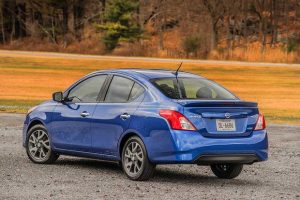
If only it didn’t have to have six air bags – the current minimum necessary to comply with Uncle’s various fatwas – Nissan could probably sell you one of these for $10k and still make a profit on each sale, too.
THE BOTTOM LINE
In addition to being an exceptionally economical car, the Versa’s a viable family car . . . and not a sad car.
Too bad they don’t make more like this.
. . .
Got a question about cars – or anything else? Click on the “ask Eric” link and send ’em in!
If you like what you’ve found here, please consider supporting EPautos.
We depend on you to keep the wheels turning!
Our donate button is here.
If you prefer not to use PayPal, our mailing address is:
EPautos
721 Hummingbird Lane SE
Copper Hill, VA 24079
PS: EPautos magnets – they’re back! are free to those who send in $20 or more to support the site. Also, the eBook – free! – is available. Click here. Just enter you email in the box on the top of the main page and we’ll email you a copy instantly!





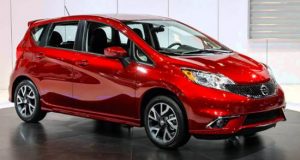
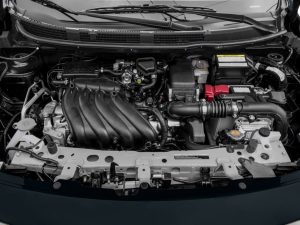
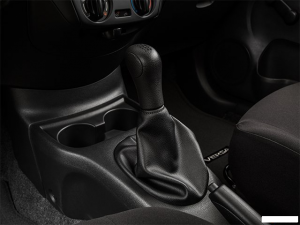
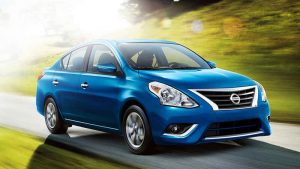
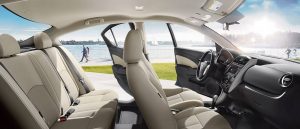







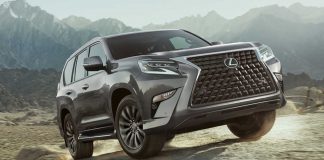
About 4-5 years ago, you reviewed the Versa at about the same time I rented one for a long, out-of-state trip in the western US. The rental had the CVT, which I hated and seemed to hold the car back.
Since then, I bought a 2015 Versa with the manual transmission (very similar to the 2017 model with the manual). I’ve found that after the break-in period (which we followed the recommended break-in procedure to a “t”), this car is much faster than advertised. We blow away most 4-cylinder Toyotas without effort, usually outrun most 4-cylinder Hondas, and easily compete with most Hyundai’s, Kia’s, and Mazda’s. The only pickups that I ever have difficulty beating all have chipped Cummins engines. 9.2 seconds seems extremely high (unless you’re driving the CVT, then it seems about right). If you’re willing to drive the thing, you can make this little MT car get up to sixty in the 7 second range. Also, we typically get 38 mpg average EVERYWHERE. A lot of city driving gets us down around 35, on the highways, we almost always get around 40-42.
The manual transmission wakes this car up in a way that does not match the marketing literature at all. One of my coworkers bought a MT 2016 Versa. She has reported the exact same experience about her car to me and is happy that she decided not to get the automatic or CVT.
Hi Shoal,
This is why I kinda pushed the manual in the review! 🙂 It is definitely the way to go. As you’ve experienced, it really wakes the car up and makes it so much more fun to drive. That you also save some bucks up front is no small thing, either.
It’s also an easy-driver. Most modern cars with manuals are. It’s among their merits. Driving a manual-equipped car also necessarily makes you a more involved – and better – driver.
I think everyone ought to have one!
They dumbed down the 4 banger a little, back in the mid-nineties it was rated at 115 HP, anyway, I was setting in the then new Fit and Versa about the time they hit the market, the seats felt much better in the Versa, got a good deal on a 07 Fit( fillup was 2.6 gallons for 120 miles yesterday) so the economy wasn’t bad and it runs very well, the little scooter makes my back scream.I don’t owe much money on the little Guy, Do you think I should pay it off and trade it on a new Versa? If I could get 4k on a trade it would be tempting.
Heres a slightly humorous story, Eric the roads around here are probably like what you are used too. one morning I came upon a Versa on its top around a bend with a slight incline, the driver a mid-ish Female was standing outside the car on Her smartphone and yakking or texting away.The car looked like you could have set it back on its wheels and driven away, so I guess that means it is a fairly safe car.
The Fit has 98K on it and I will probably pay it off sometime in next few weeks, However, the allure of a new car has Me grinding my mental gears a little.I have seen the new Versa’s advertised for 10,995 year-end closeouts and my truck is paid off( something nice about having no payment, the catch 22 is I do not want to own two vehicles as I currently do ( please advise) I am almost tempted to go back to the 4 cyl Nissan pickup days( 2 wd-doesn’t seem to snow around here anymore)
Hi Kevin!
I’d absolutely look into it. I’d bet you can get a 2017 Versa for about $11k out the door. Maybe less. There are some screaming deals available right now – as you mention. Also, if you can get say $4k on the Fit – I’d sell it privately, not trade – you could be looking at a brand-new car for about $6k.
Also, they will not be making new cars like this for much longer. The current Versa is one of the very last cars you can buy that does not have direct injection and all the rest of it.
I’d go for the manual version, too.
Well after the “screamfest” was over I talked to a Salesperson on the phone, this person told me that they had a $300 markup and the auto version was in the $14 K range, now either someone was talking out of both sides of their mouth or something was not jiving , that was the end of that( I believe that was the same dealership that wouldn’t even screw me on my Dodge pickup) allow Me to illustrate, a year old or in the ballpark Dodge pickup( 26-$27K mrsp) the truck was on sale when I bought it( think my down payment got me in the $13.5 K range) had it about a year with a year’s payments made on it around 12-13K miles on it, decided I didn’t like it, liked Nissan better got on the phone with a salesperson( turned out to be a pretty, young Woman) bring it in( I did) after they test drove my vehicle, couldnt swap payments on a brand new Nissan( I guess my truck had negative value) needless to say I will probably never deal with this bullshit dealer again.
After believe it or not 108K basically trouble free miles on the Dodge ( except for the famous brake and Dodge suspension troubles) it’s still running strong.
Aside from a few nicks and bangs its still a pretty good truck, I expect the “Powertech ” V6 to grenade before long, what would be a good upgrade engine wise to put in this thing ?I hear an LS is a good swap for power and reliability, mediocre Dodge V-8 is pretty easy, anything else seems to be a labor of love( one Guy did a pentastar, some do Hemis) what I am looking for is a bit more economy and power, the 3.7 is not particularly good on either count I looked at a GM V.6 the other day and it looks like you could put it in a go cart.
Here I stand a Jasper rebuilt V-6,(correct Number) is a bolt in. at probably around $ 2300 with the core exchange hassle( not counting installation) a junkyard anything probably around 12-$1500 plus installation, what do you think? The truck itself is a 4DR Dakota,3.92 gears LSD and in pretty good shape.
You’re probably on the conservative side there. Lower the weight of a Versa note from 2,400 pounds to close to the 1,600 pounds a 1960 VW Beetle weighed, 800 pounds less, and multiply the average 37 MPGs by 50% to reflect the lower weight, and you’re at 55 MPGs average.
For reference, a 1990 Geo Metro Xfi weighed 1,600 pounds and averaged 47 MPGs per the EPA. Equip something that light with almost three decades of automotive advances, strip out the federal mandated equipment from then, drop in a CVT transmission and 55 MPGs is doable.
Course, that is the CAFE FLEET AVERAGE a few years from now.
Still waiting for FN Trump to pick up a pen and phone and gut that CAFE mandate.
Hi Jim,
Agree emphatically regarding Trump and his failure to nix the 54.5 MPG fatwa. So far, he’s done nothing positive other than annoy the snowflakes and suck up to the cops and the military. He’s been a Good Republican in that way.
Eric, Presidente Trump kept the US out of the Paris climate treaty. That’s gotta be worth something.
Hi Charles,
That’s true; point taken!
If he puts the kibosh on the 54.5 CAFE edict, I will not only vote for I’m next time, I will put my keyboard to work for him again….
Good news today.
Individual insurance mandate is gone.
Alaska is opened for oil drilling.
Standard deduction is doubled. Children deductions are doubled.
Tax rate brackets are way down.
Paychecks will be larger soon, as soon as the new withholding tables are programmed into the payroll software.
I think Trump has gotten as much done as even Ron Paul could have if he would have been elected. Our system is only a part of a larger worldwide control apparatus.
The big difference between Trump and Paul is ego and footprint. But on policy they actually have a lot in common. Trump doesn’t mind a big government if it at least is favorable to the 5% of the world that actually lives in the US.
In a lot of ways the Libertarian Agenda is a kind of virtue signaling system. Given that we’re not going to abandon the fiction of governments anytime soon. America first is actually the least damaging philosophy possible, if you happen to be an American that is.
You can be sure China puts China first. Japan puts Japan first. In an insane world, this idea of giving commerce itself the highest priority might not even be a workable idea. The rest of the world gives fuck-all about commerce, especially other countries commerce. This idea of a libertarian world mind set was probably a ridiculous idea from the get go.
I’d like to see America start it’s own One Belt One Road, only this time from Alaska all the way down to the tip of South America. Most of those countries are miserable anyway, and many living there would gladly accept the costs to get the benefits of a First World economy, in much the same way as the rural Chinese mostly have.
Though Trumpanomics is horridly statist, and will likely remain so. There’s a lot to take encourage from. For all his bluster, Trump does have a 30 year track record of anti-government speech which anyone is free to look at if they want.
Use this calculator and see how the tax bill will affect your paycheck
http://www.cnn.com/2017/12/13/politics/calculate-americans-taxes-senate-reform-bill/index.html
Way too harsh EP. Count your blessings.
Hi Michael,
I lost track of the topic; “way too harsh”… about what?
That “having fun driving a slow car fast” mantra still Cracks Me Up! 🙂 But I agree with everything else.
One thing you don’t mention is the noise, or lack thereof. Rented a few older Generation Versas, and found a surprising lack of squeaks, rattles or buzzes. Everything else seemed to work well too. They had a satisfying, if humble integrity to them.
If that is also the case with this new model, I’d call the Versa an almost ideal “transportation appliance.” Pretty decent, inconspicuous appearance. That’s “a good thing.”
I don’t like CVTs, but you don’t buy this class of car for a BMW type experience.
Love the mention of the non-acceleration at stop lights by most of the borgs (sleeping) at the wheel. It’s the only fun you are allowed to have in a car anymore–at least in ‘burbs.
Embarrassing, but you’ll appreciate since you had a great write-up about this a few months ago. My wife has a company car, so I don’t put much effort into it. She got the cheap oil change last time; of course they forgot to tighten the filter. Once I started paying attention, too late to blame the oil changer but thank goodness not too late that it damaged the car–though in a sense, since not mine, who cares.
“Lowest cost S trim is manual transmission only. Nicer-trimmed S Plus and SV are automatic-only. No mixing and matching.”
I think this is the real reason MT sales are so poor. Almost every manufacturer for almost every model thinks the only reason to buy an MT car is save money. That only cheap people buy MT cars. No, if I bought the most expensive got-damn’d car available I still want an MT. If I bought the cheapest car available I still want an MT. And I think I am pretty close to the majority of today’s manual transmission buyers. It is purchased because we prefer it. But only the diehards put up with the limits of the lowest level trim and so forth. Everyone else caves on the MT for the rest. These marketeers are morons with their heads up their ass living in 1964 or they are intentionally trying to kill MTs without actually killing them outright.
quite true, its really the opposite now. We who buy manuals want them and spend more on cars. I had to order both my audi’s as noone carries them anymore, same with BMW.
Agreed. I would consider a manual version, but no availability of power windows or cruise control would be a deal breaker. I would never consider the CVT to get those features. Marginalizing the manual transmission may be part of their strategy to meet CAFE standards.
Looks a damn sight better than the outgoing model too! Kind of sad that the weird kind of car guy I am – the guy who prizes simplicity in design and fix it yourself-ability lusts after cars like the simple Versa and the Transit Connect. Is the e-brake any good. That’s important!
Ditto that, Zach!
I am a car guy, too… which is why I like this car. It lack most of the crap that is ruining new cars…
I drove a Versa Note rental a while back while tooling around Cape Cod. It was definitely a KAR by modern standards — there was a big jump up in luxuriousness when I got a different rental compact later in the trip — but it was a damn nice car compared to the Pinto I owned first thing out of college.
It was underpowered versus the V6 I usually drive, though the CVT helped compensate for that if you were OK with the engine screaming away at max power until you backed off the gas. Again, sub-10 0-60 times seems like a supercar compared to the glacial 16 to 17 second 0-60 times of the Pinto I used to drive, which had a top speed of 85 MPH (yes, I actually maxed it out at the speed — eventually), and revved at around 4,000 RPM at 70 MPH — assumed you dared to go that fast in such an evil handling car.
If it weren’t for Uncle’s mandates, you could build a nicer car than the Versa for probably around $6K or $8K.
Hi Jim!
Agreed on all counts.
This car is sensible – and sans the Uncle-mandated nonsense, not only could it be made for under $10k, it could be made much more fuel efficient. Imagine the same package, just 500 pounds lighter.
I bet it would average 40-45 MPG at the least – no hybrid cost/complexity needed.